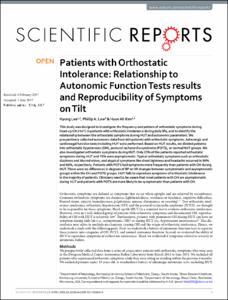Patients with Orthostatic Intolerance: Relationship to Autonomic Function Tests results and Reproducibility of Symptoms on Tilt
- Keimyung Author(s)
- Lee, Hyung; Kim, Hyun Ah
- Journal Title
- Scientific Reports
- Issued Date
- 2017
- Volume
- 7
- Issue
- 1
- Abstract
- This study was designed to investigate the frequency and pattern of orthostatic symptoms during head-up tilt (HUT) in patients with orthostatic intolerance during daily life, and to identify the relationship between the orthostatic symptoms during HUT and autonomic parameters. We prospectively collected autonomic data from 464 patients with orthostatic symptoms. Adrenergic and cardiovagal function tests including HUT were performed. Based on HUT results, we divided patients into orthostatic hypotension (OH), postural tachycardia syndrome (POTS), or normal HUT groups. We also investigated orthostatic symptoms during HUT. Only 25% of the patients reported orthostatic symptoms during HUT and 75% were asymptomatic. Typical orthostatic symptoms such as orthostatic dizziness and blurred vision, and atypical symptoms like chest tightness and headache occurred in 86% and 66%, respectively. Patients with POTS had symptoms more frequently than patients with OH during HUT. There were no differences in degrees of BP or HR changes between symptomatic and asymptomatic groups within the OH and POTS groups. HUT fails to reproduce symptoms of orthostatic intolerance in the majority of patients. Clinicians need to be aware that most patients with OH are asymptomatic during HUT and patients with POTS are more likely to be symptomatic than patients with OH.
- Publisher
- School of Medicine (의과대학)
- Citation
- Hyung Lee et al. (2017). Patients with Orthostatic Intolerance: Relationship to Autonomic Function Tests results and Reproducibility of Symptoms on Tilt. Scientific Reports, 7(1), 5706–5706. doi: 10.1038/s41598-017-05668-4
- Type
- Article
- ISSN
- 2045-2322
- Appears in Collections:
- 3. Research Institutues (연구소) > Brain Research Institute (뇌연구소)
1. School of Medicine (의과대학) > Dept. of Neurology (신경과학)
- 파일 목록
-
-
Download
 oak-2018-0824.pdf
기타 데이터 / 1.08 MB / Adobe PDF
oak-2018-0824.pdf
기타 데이터 / 1.08 MB / Adobe PDF
-
Items in Repository are protected by copyright, with all rights reserved, unless otherwise indicated.